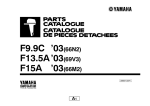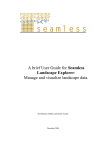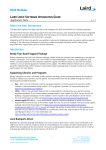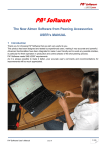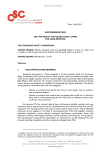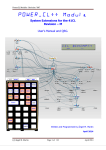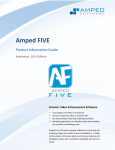Download 735 - CERN
Transcript
73s An Interactive Graphical Model For The Design And Control Of A Transfer Line Mark Plesko” Sincrotrone Trieste Padriciano 99, I-34012 TRIESTE e-mail: [email protected] the dipole magnet). When the currents of the magnetic elements are being varied, knobby always keeps the initial An interactive model for the beam transport along a conditions fixed and transforms the beam ellipses upstream and downstream of the element where the initial conditions are transfer line with graphical output is presented. The model delined allows to interactively vary quadrupole and dipole currents as The following three initial conditions are taken: well as the initial beam parameters (sigma matrix, dispersion the maximal transverse dimension of the b-camellipse Ymax and energy spread) by means of analog knobs used otherwise (i.e. the starting value of the beam cnvclope) by CAD software. The resulting beam envelope is displayed (ymax)’ the slope at the point of the maximal transverse graphically in quasi real time. Actual magnet currents can be dimension of the beam ellipse (i.e. the starting slope read from or written to the field by means of a remote of the beam envelope) procedure call. The model runs under Xl 1 windows. the slope at the point y=O of the beam ellipse (i.e. (Y’h the slope of the particle which goes through the beam caltre) I. INTRODUCTION Here y stands for either the horizontal direction (x) or the The model is applicable for the design of a transfer line. and vertical (z). In terms of Twiss parameters, the following during its commissioning and control. It displays the beam relations hold [ 11: envelope in the horizontal and in the vertical plane for a given lattice and given initial conditions of the beam. In addition, y’() =: F/i ymax’ = -Cf. l/Tmax = &ji Y the user can use knobs to vary the currents in the magnets of the transfer line and he/she gets an immediate response. The knobs can be used also to vary the initial conditions of These parameters have been chosen, because they represent the beam at any given point along the transfer lint and also to the most intuitive set of variables for the. display of the beam vary the energy spread and the dispersion vector. Thus the user envelope. They are directly related to the graphical output. has a complete interactive control over the parameters of the. The initial dispersion D, its derivative D’ and the energy model, which is therefore called knobby. spread dp/p are used for modelling the off-energy envelope of’ Along with other features, the model reads or writes the the beam. currents of the power supplies directly from the control system. The beam envelope is calculated by matrix B. The Structure of the Transfer Line multiplication [l]. The graphical output which is in colours The transfer line consists of elements, which may bc and the knob event handling is performed with the package Klib [2] under X11 windows on an HP-BOO work station magnetic (dipoles or quadrupole), drift spacesor labels of xro length (monitors or fluorescent screens). Magnetic elements computer. may be grouped into families. A family is considered a set of II. THE PARAMETERS OF THE MODEL magnetic elements, which have the same optical properties and are powered in series by a single power supply. The knobs which vary the element strengths are actually A. The Initial Conditions assigned to families (i.e. power supplies), thus several The initial conditions define the horizontal dispersion and elements can be varied simultaneously with one knob. the beam ellipse in both planes. Knobby allows the initial The input parameters for the elements are same as the ones conditions to be defined at any element along the transfer line, used in TRANSPORT 131,Currently the only type of magnets not only at the first one. This is useful when the beam that arc recognized by knobby are normal quadrupoles and conditions are determined by a measurement, which is usually rectangular horizontal bending magnets, which may have a related to an element somewhere in the transfer line. It is also gradient superimposed. No skew elements are used. needed to match the transfer line to a given exit condition or to In contrast to an off-line model like TRANSPORT, also certain conditions in the transfer line (e.g. given beam sizes in the actual currents of the power supplies have to be given. The actual current of a power supply may be read in from the hardware if knobby is connected to a real transfer line or given * Supportedby an ICTP fellowship. Abstract 736 as input parameter in case knobby is used during the design phase. For the former, an additional value has to be given which gives the maximal current a power supply can provide. This value is important to prevent a current, which would exceed the capabilities of the power supply, to be applied. The elements of the types fluorescent screen and monitor have zero field, zero length and zero current. These types are used to indi’cate the position of a point where the beam envelope can be measured. In the graphical output of knobby, this is shown as vertical green line. C. The Graphical Outpur The graphical output of knobby is directed into a special window, which is opened and closed during run-time. In order to minimize the drawing time and thus to avoid flickering, only the mosf. important information is given. The size of the envelope is plotted for five points in each element. This might not be very accurate for long drift spaces, but it is a good compromise between time and resolution, since the exact beam size in drift cells is usually not of interest. If a better resolution is wanted, the drift cell can always be split in two or more. The vertical axis is labeled, while the horizontal is not. On the abscise only the boxes representing the positions and sizes of the magnetic elemcntc; are shown, All lengths arc displayed to scale. Below the boxes of the magnetic elements the currents of their power supplies are shown. By varying the corresponding knobs also these values change accordingly and the new calculated envelopes are displayed immediately. The horizontal and vertical envelopes are drawn on the same graph with different colours. The horizontal envelope is shown twice to emphasize the difference between on- and offenergy particles. The envelope for on-energy particles (i.e.without dispersion) is displayed in dark blue, the horizontal envelope including dispersion is shown in light blue. The colour of the vertic.al envelope is red. III. THE FEATURES OF THE MODEL Here, only the most interesting features are described. See reference [4] for a detail description of the model’s usage. A. The Modes of Operation The default mode is the simulation mode. In this mode the initial settings of the magnetic elcmcnts arc read from the input file and the user may change the strengths via knobs. If the user wan& to see the expected envelope due to the real magnetic fields in the magnetic elements, he/she selects the real mode. In this mode the currents are read in from the hardware via the remote procedure call mechanism [5] when the graphic window is opened first. After that, the user may again use the knobs to simulate different currents. The real currents are read in only once after each request. The apply mode is selected after a setting has been achieved with- the model, which should be realizedon the real transfer line. Then the values of the currents in the model are applied to the hardware via a remote procedure call. Knobby checks first if the selected currents do not exceed the maximal allowed currents that were given in the input file. Only the currents whose absolute values are below the maximum arc applied. For the others, a warning is issued in the terminal window. After the apply is performed, knobby goes back into the simulation mode and allows the user to turn the knobs again. For a new setting of the hardware, another apply must be issued. The user may want to print an envelope plol on a color or b&w plotter/printer. The print mode changes the colours of the current graphic window for a better printing contrast. The screen hardcopy is done by the user with Xl 1 commands. B. The Use of Knobs For the HP work stations there exists a panel with nine quasi analog knobs for the use of CAD software. With these knobs the currents in the power supplies of the magnetic elements are simulated. The knobs have no upper or lower limits, thus all possible currents may be set. The knobs may be used also to change. rhc initial conditions. The user assigns three knobs, one to each parameter y,,, , (Ymax)’ and (y’)~ with y being x or z, respectively. If another option is selected, the three knobs are assigned to dp/p, D and D’ for changing the initial conditions of the off-energy particles. When the graphic window is opened the three bottom knobs of the nine knob panel may be turned to change the initial conditions in quasi real time. In the top left comer of the window the current values of the initial conditions arc displayed. Due to the limited number of knobs, only on set of initial conditions may be changed at a time. If more than six power supplies (i.c. magnetic clement families) arc present and the knob control of the initial conditions is requested, then only the first six families may be controlled by the knobs of the knob panel, as the last three knobs are reserved for the initial conditions. IV.THEAPPLICATION OFKNOBBY AI‘ ELETI'RA ELECTRA is a third generation synchrotron light source being built at Trieste 161.Knobby will be used to operate the transfer line from the full energy linac to the storage ring, in particular during the commissioning of the linac and the transfer line. Although knobby is a general program. which can take any lattice from an input file, some details are nevertheless specific for the equipment at ELETTRA. The model knobby has been already successfully used to developed the optics layout (see figure 1) of the diagnostic linr for the commissioning of the 30-100 MeV linac [7] and to operate the diagnostic line during emittance measurements. v. ACKN~WLEM;EMENTS I gratefully acknowledge the help of Franc0 Potepan who provided me with the powerful Klib package which he has 737 developed for his personal use. I also thank Carlo Bocchetta for suggestions how to make the model efficient for the users. VI. REFERENCES [l] KSteffen, Basic Course on Accelerakw Oprics, CERN 85-19, .,--. 1985 [2] F.Potepan. private communication. [3] K.L.Brown et al., TRANSPORT, CERN 80-04, 1980. [4] M.Plesko. User Manual for knobby, rhe Model of fhe Diagnosric Line. Sincrotrone Tricste, ST/M-92/4, March 1992. [5] M.Mignacco. Remote Procedure Call in the ELETTRA Conrrol System. Sincrotrone Trieste. ST/M-89/4, March 1989. [6] ELE’ITRA Conceptual Design Report. Sincrotrone Trieste, April 1989. [7] C.J.Bocchettaet al., The Diqnosric Tesrs of the ELEl”l’RA proceedings. Line for rhe Acceptance 100 MeV Pre-injector, these , ;!Gj;,‘.;:~,:,i,‘,r,,l,,!i,!l;l,‘l”liili.’,il;,’,,~, ‘, lj ’ : Iii‘, ,,“‘(‘qit;,j/:;!il’$‘., ‘l.i1~@1’: I,/, J 4 , : ,(I, f ! : //jj!‘I., /,.j’ll$ 1-q,,ih IIf ;- 1,::/,m I, ,i,“<‘, 5 4 ~~~~~“‘~ 3 2 I-.-;---:: l- I 12.000.00-8.10 -8200.00225 Figure 1. The be;lm envelope in the diagnostic line optimized for the measurement of the horizontal cmittance for the 75 MeV FEL mode of the 100 MeV linac. The numbers given below the magnets are the pole tip fields in units of 10m2T. The ordinate labels stand for the beam size in mm.




